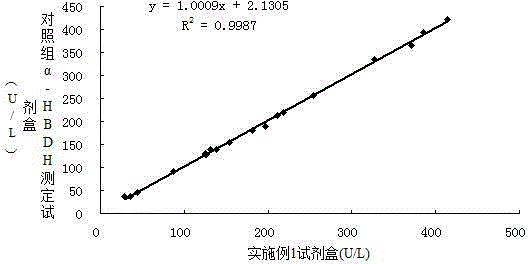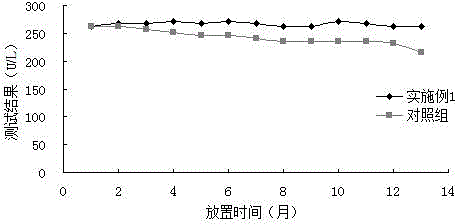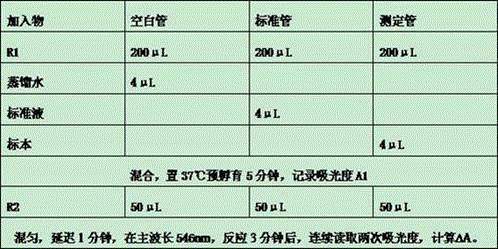Stable alpha-hydroxybutyrate dehydrogenase reagent with high interference resistance capacity and detection method
A hydroxybutyrate dehydrogenase and detection method technology, which is applied in the field of α-hydroxybutyrate dehydrogenase detection reagents, can solve the problems of poor stability of the reagent substrate NADH, etc., and achieve enhanced stability and anti-interference ability, Inexpensive and easy to use
- Summary
- Abstract
- Description
- Claims
- Application Information
AI Technical Summary
Problems solved by technology
Method used
Image
Examples
Embodiment 1
[0039] α-Hydroxybutyrate dehydrogenase detection reagent, including reagent R1 and reagent R2:
[0040] 1) The composition of its R1 is:
[0041] PIPES (piperazine-1,4-diethanesulfonic acid) buffer (pH=7.4, 25°C) ·························· 50mmol / L
[0042] Disodium ethylenediaminetetraacetic acid (EDTA-2Na) ····································································· 3mmol / L,
[0043] alpha-ketobutyric acid ··································································································· 5mmol / L,
[0044] Lauryl dimethyl betaine ·············································································· 2g / L,
[0045] Preservative NaN 3······························································································· 0.5g / L
[0046] 2) The components of reagent R2 are:
[0047] PIPES (piperazine-1,4-diethanesulfonic acid) buffer (pH=7.4, 25°C) ·························· 100mmol / L
[0048] NADH ····························...
Embodiment 2
[0061] Interfering test
[0062] Take fresh mixed serum, divide it into 2 equal parts, and then divide each equal part into 4 equal parts, add different interfering substances, so that the concentration in the serum reaches the requirements in Table 2. Then respectively use the reagent obtained in Example 1, and the α-hydroxybutyrate dehydrogenase (α-HBDH) reagent that is common and recognized in the market to compare and measure the activity of α-HBDH in the serum simultaneously, and the measured results of the control group are the same as those after adding different interfering substances. The measurement results of each group are shown in Table 2. Relative deviation (%) = (measuring mean value of interference samples - measuring mean value of control samples) / measured mean value of control samples × 100%.
[0063] It can be seen from Table 2 that the reagent of Example 1 has no obvious interference on the test results when ascorbic acid≤50mg / dL, bilirubin≤1026μmol / L, and...
Embodiment 3
[0067] correlation experiment
[0068] Utilize the formula of Example 1 to prepare the reagents, and carry out comparative detection with the α-hydroxybutyrate dehydrogenase kit of a company approved by the State Food and Drug Administration, which is common in the market, and detect 20 clinical serum samples at the same time, and the detection results are shown in the table 3. And obtained the correlation curve of the two reagents (such as figure 1 Shown), the test results show that the correlation coefficient of the two kits is 0.9994, indicating that there is a great correlation between the two.
[0069] Table 3 Comparative test results of the reagent in Example 1 and the common and recognized α-hydroxybutyrate dehydrogenase assay kit in the market
[0070] .
PUM
 Login to View More
Login to View More Abstract
Description
Claims
Application Information
 Login to View More
Login to View More - R&D
- Intellectual Property
- Life Sciences
- Materials
- Tech Scout
- Unparalleled Data Quality
- Higher Quality Content
- 60% Fewer Hallucinations
Browse by: Latest US Patents, China's latest patents, Technical Efficacy Thesaurus, Application Domain, Technology Topic, Popular Technical Reports.
© 2025 PatSnap. All rights reserved.Legal|Privacy policy|Modern Slavery Act Transparency Statement|Sitemap|About US| Contact US: help@patsnap.com



